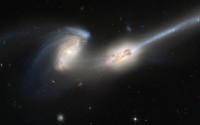When galaxies collide
- Date
- 30 Nov 2009
- Start time
- 7:30 PM
- Venue
- The Hospitium
- Speaker
- Dr Richard De Grijs

When galaxies collide …
by Professor Richard de Grijs, Department of Physics & Astronomy, University of Sheffield
Joint lecture with the Institute of Physics, Yorkshire Branch
Studying galactic interactions is like sifting through the forensic evidence at a crime scene. Astronomers wade through the debris of a violent encounter, collecting clues so that they can reconstruct the celestial crime to determine when it happened. Take the case of Messier 82, a small, nearby galaxy that long ago bumped into its larger neighbour, Messier 81. When did this violent encounter occur?
New infrared and visible-light pictures from the Hubble Space Telescope reveal for the first time important details of large clusters of stars, which arose from the interaction. The talk focuses on the train wrecks resulting from galaxy collisions and the implications for us in the Milky Way.
Report
by Carole Smith
The beauty of the universe disguises its terrifying scale and, technical problems notwithstanding, the quality of illustrations we were shown of galaxies in all their variety of shapes, sizes and ages was extraordinary and evocative. Glimpses of galaxy clusters near the edge of the universe still reveal vast distances between them. Galaxies are more affected gravitationally by neighbouring galaxies than they are by the expansion of the universe. They tend to interact and keep together even as everything draws apart. Gravitational interaction among galaxy groups does not cause actual collisions between stars just between dust clouds, whose compression produces violent star formation, itself a clue to past galactic interaction. The distances between stars, even in colliding galaxies, remain comparable to the space between a few wasps over the whole continent of Europe, a slightly comforting analogy for humans living relatively close to our interacting neighbour the Andromeda galaxy.